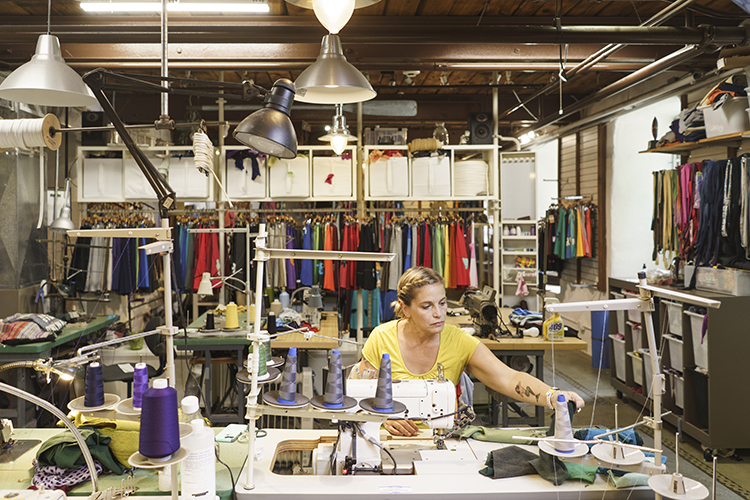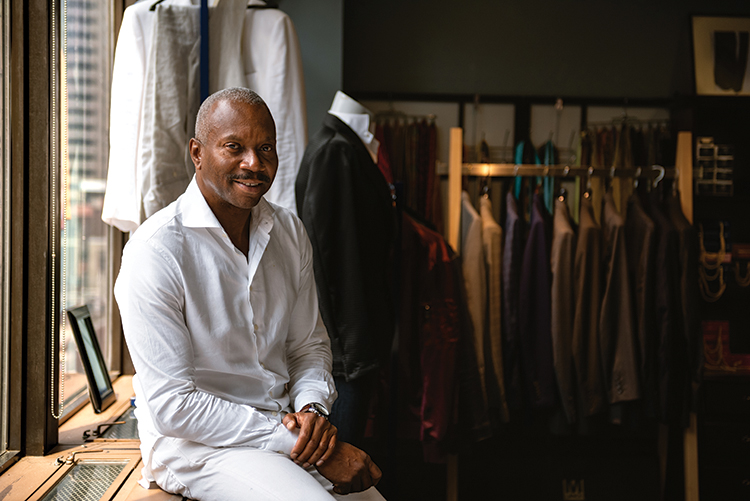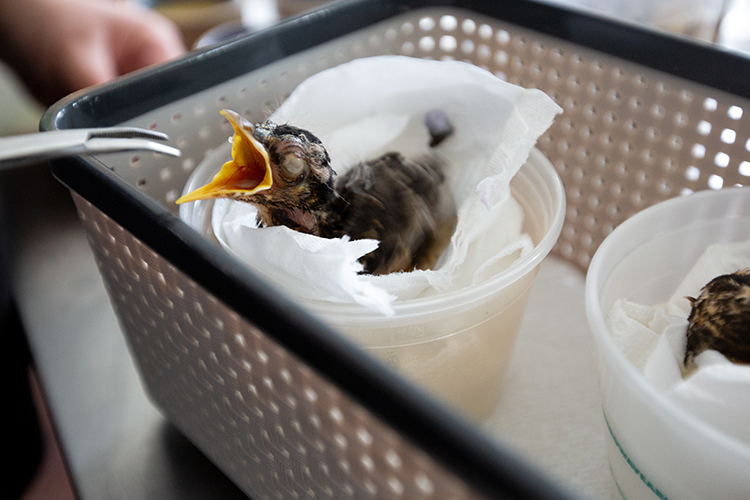Design of the times
By Alexandra W. Jones
“Sale” in big block letters reads a sign inside a window at the H&M at 17th and Walnut. On the discount racks hang shirts, sweaters and T-shirts in a wide variety of styles for as little as $5 each. For $6, a new dress can be yours; for $9, a new pair of jeans.
For the cash-strapped buyer, “fast fashion” prices are tempting, and demand for stylish, cheap clothing sustains most big retailers today. Brands like H&M and Forever 21 and department stores and discount retailers like Marshalls and TJ Maxx all rely on this business model. Fast fashion means turning over inventory at a rapid rate, sometimes cycling through as many as 52 “micro-seasons” a year.
This system thrives on consumers acting on impulse, and while costs are minimal, the average piece of fast fashion is expected to be worn fewer than 10 times. To keep up with buyers’ ever-present demand for new clothing, the production end of the fast fashion spectrum survives by cutting corners. About every three weeks, retailers hold sales to make room for new merchandise, with major markdowns on clothes.
Despite what you may assume—that machines took over clothing production long ago—most garments remain sewn by hand because fabric can be especially fickle. To keep up with the demands of retailers, factory workers, who usually work long hours for less than minimum wage, end up sewing hundreds of items a day.
Because clothing is churned out quickly, there’s a greater demand for textiles, and most require resource-intensive materials. Cotton, for instance, is the world’s most pesticide-dependent crop. The amount of cotton needed to make a T-shirt requires about one third of a pound of pesticide.
To cut costs, retailers also make clothes out of synthetic fibers like polyester, rayon, spandex and nylon. While this production process avoids the use of pesticides, the factory workers who create these fabrics are exposed to dangerous alcohols and acids, and the fabrics can take up to 200 years to decompose.
For the consumer, it’s a convenient but morally problematic system. That’s why “ethical fashion,” the practice of choosing clothing that is designed, sourced and manufactured in a way that maximizes the benefits to people and the environment while minimizing the negative impacts is becoming a popular movement. Here are three local businesses—two of them new, one of them a decade old—trying to put ethics back into fashion.
A new life for old T-shirts
When you visit the Sardine Clothing Company’s small, first-floor store off Manayunk Avenue, two blurry furballs may race to greet you at the door. In owner Maryanne Petrus Gilbert’s sewing studio, her dogs Tuna and Guppie are her most consistent, and excitable, co-workers.
Although a jeweler by training, Petrus Gilbert discovered her passion for sewing in 2006,when she began using old T-shirts to make potty-training pants that her two-year-old son could easily pull up and down on his own. Soon after, she began experimenting with making clothing for herself.
“I fell in love with the whole process [of] taking something like the T-shirt, which is like the lowliest form of fashion, and reusing it,” she says.
She opened Sardine in 2009. Today 80 percent of her handmade, upcycled inventory is made from old T-shirts. Using Salvation Armys in Roxborough and Bucks County as material reservoirs, Petrus Gilbert handpicks most of the fabric for the designs on her shelves.
Once this material is in the studio, the process becomes fairly straightforward. A few local contract sewers disassemble the existing clothing, following patterns to make bases for Sardine’s skirts, dresses and T-shirts. Then, on her ivory sewing machine, Petrus Gilbert creates the designs that have become the mark of her work: little shapes like flowers, anchors, skeletons, foxes that she ultimately adheres to the to the final product.
“That’s the one thing that sets me apart,” she says. Every week, she and her team make around 20 new items, which are usually priced between $35 and $100. It’s not as cheap as fast fashion, she says, but she wants her clothes to last a lifetime
“When somebody buys a skirt from me, if they get bigger, if they get smaller, or if they get a stain on it, they can send it back to me and I will re-work it so they can continue to wear it,” Petrus Gilbert explains, noting that part of her business model is having an ongoing relationship with her customers.
If she doesn’t have exactly what her customers want, they can custom order it. One of Petrus Gilbert’s regulars, a school teacher who lives on the Main Line, has her create new skirts for each of her lessons, not unlike Ms. Frizzle, the heroine of The Magic School Bus series.
“This year she’s focusing on Africa, so we’re going to do a lot of African animals,” Petrus Gilbert says. Past skirts have included artwork detailing animal and plant cells and the solar system.
Sardine as a company and a brand relies on Petrus Gilbert’s distinctive artwork. Because she personally sews all the art appliques, her company can’t get much bigger. But her hope is that in creating a business that salvages used textiles, she can change others’ attitudes about consumption and waste.
“Be it recycling, composting, turning off lights or taking the stairs, it all adds up,” her site reads. “One little Sardine is not much. A school of sardines can create a cloud in the water you can see from an airplane.”
A subscription to gently used clothing
Subscription box services for clothing is a trend that began within the last decade. A few of the most popular name brands are Stitch Fix, Trunk Club, and Le Tote, but dozens of fast fashion companies from Fabletics to Ann Taylor now deliver trendy and stylish clothing right to your door for a low monthly fee.
And We Evolve, a Philadelphia company based in Port Richmond, takes that idea and adds a sustainable twist. It’s a secondhand online store and subscription box service for people who want to expand their wardrobes without supporting fast fashion retailers directly. Rather, they can get their style fix shipped to them from AWE’s studio space, which houses racks of donated designer clothing and accessories.
The company was co-founded by Liz Funk and Alisha Ebling in November 2017—Funk and Ebling met during the summer of that year at a branding workshop, where they discovered a shared interest in secondhand clothing and sustainability.
For Funk, the idea of creating a secondhand online store came about because of a closetful of unworn clothes. She thought there might be a niche in the market for a company that recycles lightly used clothing. Ebling, who at the time ran her own sustainability blog, loved the idea of a business that recycles fast fashion items.
This past spring, AWE debuted secondhand subscription boxes. Since then, Funk said, business has been booming.
“We kind of realized we had an opportunity there,” Ebling says. “People don’t like the idea of picking through things, so subscription boxes make sense because they’re very convenient. It’s delivered right to you.”
Similar to Stitch Fix, the AWE Box is for monthly subscribers. For a flat fee of $20, they receive a box every month that Funk and Ebling say takes them about an hour to curate. Each box has one full three-component outfit and two additional pieces based on the customer’s questionnaire answers. Subscribers can keep everything in the box for $100 or send back what they don’t want and pay per item.
Soon, Ebling says, AWE is going to transition away from its online store to focus solely on subscription boxes, which both founders think encourage women to have a more purposeful relationship with their clothes. Some of their subscribers, she said, have even begun to give their unused clothin
g directly to the company.
“We are constantly getting donations from women who think that what we’re doing is meaningful,” Funk says. “They know that their clothes are going to end up being loved by another woman.”
Blue jeans deconstructed and reconstructed
During her first year at the University of Delaware, Morgan Young attended a panel for freshman design students. Of the five presenters, one talked about the environmental recklessness of fast fashions and how the future of the fashion industry overall depends on sustainability.
The apparel design major was hooked.
It dawned on Young how much material was out there to use. Out of the 68 pounds of clothing that Americans discard per year, only one-seventh is recycled or reused. Donation outlets like Goodwill and Salvation Army only sell about half of their donations on site, she said. The other half go to textile and rag dealers.
A few years after attending the panel, Young met marketing major Greg Harder. Combining her passion for design with his entrepreneurial spirit, the two launched AndAgain Co., a company that uses vintage denim to create modern, contemporary apparel, in September 2016.
The pair, who just graduated this May, work out of a 400-square-foot flat in downtown Wilmington. Their office has two messy desks, a pair of sewing machines, and a packing table for cutting and pattern making. Toward the front, they store the denim they buy from Goodwill that would otherwise have been turned into rags.
Here, however, it is deconstructed and re-sewn to create new apparel. It’s a practice that cuts down on valuable environmental resources used to create new textile materials. She designs all the company’s patterns, which go from her sketchbook to AndAgain’s online store in about a month.
Everything AndAgain sells is made in the United States—all the patterns are sewn by individual contractors from around the country.
The site features denim bomber jackets, crew-cut sweaters, and tank tops with wave-inspired patterns adorning the front. In the description of each piece, AndAgain notes that by using repurposed material, each of its garments saves more than 2,000 gallons of water.
“I feel like our business is creating a new culture around sustainability in the fashion industry,” Young says.
AndAgain has partnered with artists from Florida, Texas, and Westchester, allowing them to use their denim as canvases for painting, embroidering and screen-printing.
“I’m really emotionally tied to working with artists,” Young said. “It’s great to see them get so excited about working with a brand like ours that gives them a chance to showcase their artwork.”
“My biggest goal for us would be continuing this push towards this very artisan side of the brand,” Harder agreed, noting that connections with established artists also widens the AndAgain’s customer base. The company hopes to release a series of 10-piece collections with new artists this fall.







